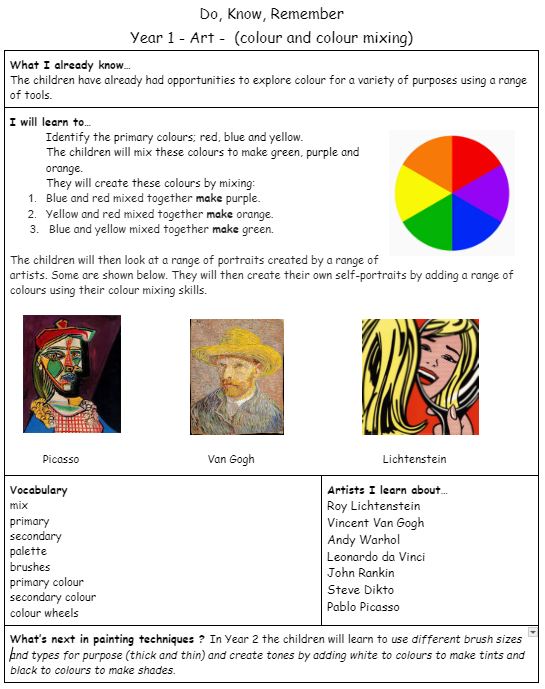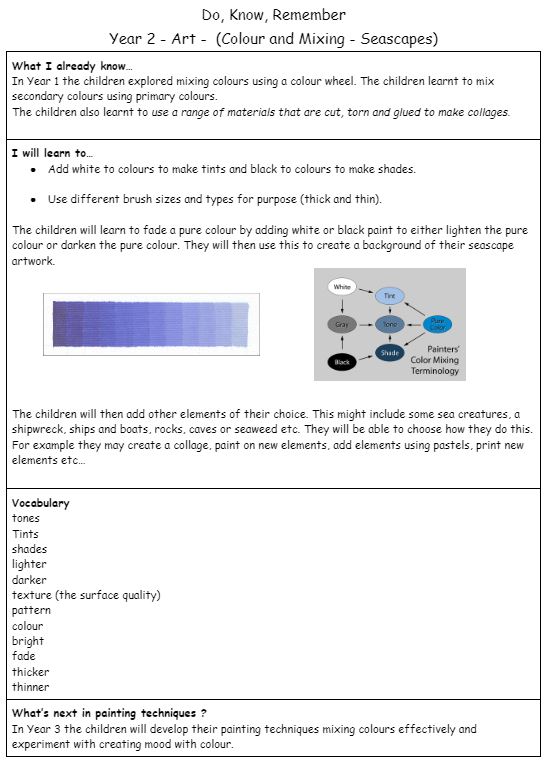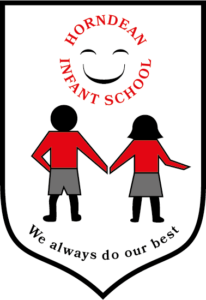|
|
Autumn 1 |
Autumn 2
Christmas cards |
Spring 1 |
Spring 2
Mother’s Day cards
Easter cards |
Summer 1
Father’s Day cards |
Summer 2 |
| Nursery |
|
Marvellous Me! & Kaleidoscopes and Rainbows |
Dark Nights and Special Lights & The Magic Toy Box |
Adventures into Storyland & Winter Wonderland |
To Infinity and Beyond! & Superheroes and Monsters |
Roots, Shoots and Muddy Boots |
Beneath the Waves & Time to Shine! |
|
Painting – colour exploration
Printing – rollers and stampers
Texture – sensory activities
Collage – gluing and sticking skills
3D Form – playdough and salt dough – exploring and printing into dough.
Drawing – exploring mark making tools and giving meanings to marks / Self Portraits
Artists – Giuseppe Archimboldo / Wassily Kandinsky / Pier Mondrian |
Painting – exploring how colours change and the effects of different tools
Printing – with natural materials / leaf rubbings
Texture – describing textures
Collage – creating images from different media
3D Form – playdough and salt dough – moulding with support.
Drawing – in different media – shaving foam, mud, sand
Artists – Andy Goldsworthy |
Painting – exploring how colours can change / straw blowing
Printing – Block colours / brick rubbings
Texture – experiment to create different textures
Collage – creating simple collages (Winter collage / Fire collage)
3D Form – Papier Mache (Dragon Eggs)
Drawing – using different surfaces / introduction to pastels
Artists – Paul Klee – creating lines and closed shapes. |
Painting – exploring colour mixing Introduction to powder paints / splat painting
Printing – patterns / stencil rubbings
Texture – experiment to create different textures – sand / wax crayons
Collage – manipulating materials – tear, scrunch, twist, rip, and roll, fold.
3D Form – Manipulate playdough – rolling, patting, making balls, sausages, flattening
Drawing – use drawings to represent ideas and objects.
Introduction to charcoal
Artists – Jackson Pollock / Vincent Van Gough |
Painting – exploring colour mixing Introduction to watercolours
Printing – printing into dough (fossils)
Texture – combining media to create new effects – marbling
Collage – selecting own materials to create different images
3D Form – Papier Mache Planets (Earth Day)
Drawing – draw with increasing complexity and detail – second self portraits with key features
Artists – Claude Monet / Henri Matisse
|
Painting – choosing particular colours for a purpose
Observational paintings and artistic techniques – pointillism
Printing – Bubble printing / coin rubbings
Texture – combining media to create new effects – tea staining
Collage – selecting own materials to create different images
3D Form – Introduction to clay (Minibeasts / Cress Pots)
Drawing – draw with increasing complexity and detail – observational drawings – fish
Artists – Georges Seurat / Bernard Leech / Georgia O’Keefe
|
| Year F |
|
Knock, Knock, Here I Am |
People who help us |
Magic carpet ride |
Monster Madness! |
Ready, Steady, Grow! |
Fun at the Farm |
|
Mark making with pens, pencils, crayons
Painting with poster paints variety of tools
Painting routines and expectations
Exploring colour mixing
Printing into dough |
Mixed media and tool firework pictures
Rubbings
Printing Xmas cards
Knotting Christmas trees
Bubble printing
Transient art |
Junk modelling area introduced
Exploring collage
Introduction to pastels and charcoal |
Purposeful colour mixing
Introduction to powder paints and watercolours. |
Clay minibeasts
Paper flowers
making own playdough |
Collages and peer review |
| Year 1 |
|
Awesome Animals |
Superheroes |
Tales of the river bank |
|
|
|
Autumn 1
Colour Chaos
Introduce colour mixing and create a colour wheel |
to use a range of materials creatively to design and make products
to use drawing and painting to develop and share their ideas, experiences and imagination
to develop a wide range of art and design techniques in using colour, pattern, texture, line, shape, form and space
learn about the work of a range of artists, craft makers and designers, describing the differences and similarities between different practices and disciplines, and making links to their own work. |
to use a range of materials creatively to design and make products
to use drawing and painting to develop and share their ideas, experiences and imagination
to develop a wide range of art and design techniques in using colour, pattern, texture, line, shape, form and space
learn about the work of a range of artists, craft makers and designers, describing the differences and similarities between different practices and disciplines, and making links to their own work. |
to use a range of materials creatively to design and make products
to use drawing, painting and sculpture to develop and share their ideas, experiences and imagination
to develop a wide range of art and design techniques in using colour, pattern, texture, line, shape, form and space
learn about the work of a range of artists, craft makers and designers, describing the differences and similarities between different practices and disciplines, and making links to their own work. |
|
|
Collage- Re-create the background of a picture from Monkey Puzzle.
–Use a range of materials that are cut, torn and glued to make collages
Drawing- Draw Monkey from Monkey Puzzle to place on collage background.
-Extend the variety of drawing tools.
–Can draw lines of different sizes and thicknesses.
–Colour own work neatly following the lines. |
Printing-Christmas Paper
-Print with a range of hard and soft materials including objects such as corks, sponges, lego bricks, bottle tops
–Mimic print from the environment |
Drawing- Draw their face using a photo of themselves based on pics by Roy Lichtenstein
-Extend the variety of drawing tools.
–Can draw lines of different sizes and thicknesses.
–Colour own work neatly following the lines.
Painting- Create a colour wheel
Complete face sketches with colour paint.
-Use ready mix paints
-Mix primary colours to make secondary colours. – Make colour wheels |
Textiles Weaving- Create superhero capes.
-Use weaving with card or materials to create pattern-
Explore colour in weaving e.g. mixing colours for paper strips to weave. Discuss how textiles create things – curtains, clothing, decoration
-Use plaiting
Use plaiting |
3D Form – Designing and making a clay Bog Baby
-Use a combination of shapes
-Use rolled up paper, straws, paper, card and clay as materials. |
Painting – Introduction to watercolours
-Use ready mix paints |
| Year 2 |
Autumn 1
Colour Chaos
RECAP colour mixing and create a colour wheel |
Dragons, Damsels and Dashing Knights
to use a range of materials creatively to design and make products
to use drawing, painting and sculpture to develop and share their ideas, experiences and imagination
to develop a wide range of art and design techniques in using colour, pattern, texture, line, shape, form and space
learn about the work of a range of artists, craft makers and designers, describing the differences and similarities between different practices and disciplines, and making links to their own work. |
Extreme Explorers
to use a range of materials creatively to design and make products
to use drawing, painting and sculpture to develop and share their ideas, experiences and imagination
to develop a wide range of art and design techniques in using colour, pattern, texture, line, shape, form and space
learn about the work of a range of artists, craft makers and designers, describing the differences and similarities between different practices and disciplines, and making links to their own work. |
Seeds, Leaves and Buzzing Bees
to use a range of materials creatively to design and make products
to use drawing and painting to develop and share their ideas, experiences and imagination
to develop a wide range of art and design techniques in using colour, pattern, texture, line, shape, form and space
learn about the work of a range of artists, craft makers and designers, describing the differences and similarities between different practices and disciplines, and making links to their own work. |
|
Drawing- Use a range of media to create castle pictures. Incorporate variety of tones and textures using pencil skills and layering media.
Printing- Create a castle using a range of materials to print brickwork/stonework. Create a ‘printing block’ using string to make a flag. |
3D Form- Create clay poppies for Remembrance learning to attach different sections of clay.
Computing Link
Use a computer program to create art. |
Drawing and Painting- Observational drawing of mackerel and the addition of watercolour
Paints.
Painting/Collage- Seascapes. tints and shades for background. Collage skills for additional sea creatures… |
3D Form-
Create aliens using a range of materials using techniques such as rolling, cutting, moulding and carving. |
Collage- Create scenes for Cement Land and Beautiful Land from Frog Belly Rat Bone.
Drawing and Painting- Draw and add media to create Frog Belly Rat Bone pictures. |
Textiles- Sewing bunting- DT LINK. |


